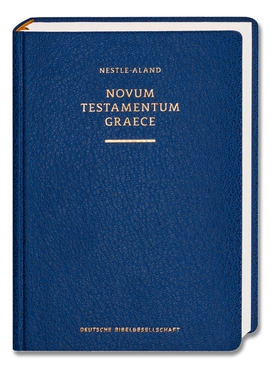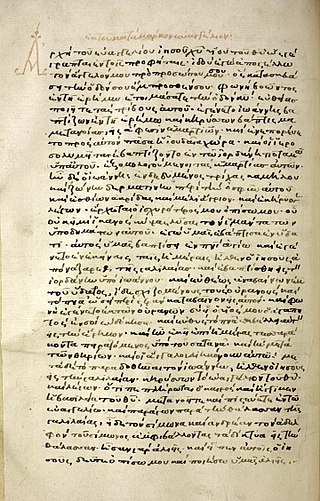
The Codex Sinaiticus, designated by siglum א [Aleph] or 01, δ 2, also called Sinai Bible, is a fourth-century Christian manuscript of a Greek Bible, containing the majority of the Greek Old Testament, including the deuterocanonical books, and the Greek New Testament, with both the Epistle of Barnabas and the Shepherd of Hermas included. It is written in uncial letters on parchment. It is one of the four great uncial codices. Along with Codex Alexandrinus and Codex Vaticanus, it is one of the earliest and most complete manuscripts of the Bible, and contains the oldest complete copy of the New Testament. It is a historical treasure, and using the study of comparative writing styles (palaeography), it has been dated to the mid-fourth century.

The Codex Vaticanus, designated by siglum B or 03, δ 1, is a Christian manuscript of a Greek Bible, containing the majority of the Greek Old Testament and the majority of the Greek New Testament. It is one of the four great uncial codices. Along with Codex Alexandrinus and Codex Sinaiticus, it is one of the earliest and most complete manuscripts of the Bible. Using the study of comparative writing styles (palaeography), it has been dated to the 4th century.

Textual criticism is a branch of textual scholarship, philology, and literary criticism that is concerned with the identification of textual variants, or different versions, of either manuscripts (mss) or of printed books. Such texts may range in dates from the earliest writing in cuneiform, impressed on clay, for example, to multiple unpublished versions of a 21st-century author's work. Historically, scribes who were paid to copy documents may have been literate, but many were simply copyists, mimicking the shapes of letters without necessarily understanding what they meant. This means that unintentional alterations were common when copying manuscripts by hand. Intentional alterations may have been made as well, for example, the censoring of printed work for political, religious or cultural reasons.

Textus Receptus refers to the succession of printed editions of the Greek New Testament from Erasmus's Novum Instrumentum omne (1516) to the 1633 Elzevir edition.

The Bible has been translated into many languages from the biblical languages of Hebrew, Aramaic, and Greek. As of September 2023 all of the Bible has been translated into 736 languages, the New Testament has been translated into an additional 1,658 languages, and smaller portions of the Bible have been translated into 1,264 other languages according to Wycliffe Global Alliance. Thus, at least some portions of the Bible have been translated into 3,658 languages.
Lectio difficilior potior is a main principle of textual criticism. Where different manuscripts conflict on a particular reading, the principle suggests that the more unusual one is more likely the original. The presupposition is that scribes would more often replace odd words and hard sayings with more familiar and less controversial ones, than vice versa. Lectio difficilior potior is an internal criterion, which is independent of criteria for evaluating the manuscript in which it is found, and that it is as applicable to manuscripts of a roman courtois, a classical poet, or a Sanskrit epic as it is to a biblical text.
Biblical studies is the academic application of a set of diverse disciplines to the study of the Bible. For its theory and methods, the field draws on disciplines ranging from ancient history, historical criticism, philology, theology, textual criticism, literary criticism, historical backgrounds, mythology, and comparative religion.

The "Magdalen" papyrus was purchased in Luxor, Egypt in 1901 by Reverend Charles Bousfield Huleatt (1863–1908), who identified the Greek fragments as portions of the Gospel of Matthew and presented them to Magdalen College, Oxford, where they are catalogued as P. Magdalen Greek 17 from which they acquired their name. When the fragments were published by Colin Henderson Roberts in 1953, illustrated with a photograph, the hand was characterized as "an early predecessor of the so-called 'Biblical Uncial'" which began to emerge towards the end of the 2nd century. The uncial style is epitomised by the later biblical Codex Vaticanus and Codex Sinaiticus. Comparative paleographical analysis has remained the methodological key for dating the manuscript, but there is no consensus on the dating of the papyrus. Estimates have ranged from the 1st century to the 4th century AD.

Papyrus 46, designated by siglum 𝔓46, is an early Greek New Testament manuscript written on papyrus, and is one of the manuscripts comprising the Chester Beatty Papyri. Manuscripts among the Chester Beatty Papyri have had several provenances associated with them, the most likely being the Faiyum. It has been paleographically dated between 175 and 225, or early 3rd century CE. It contains verses from the Pauline Epistles of Romans, 1 Corinthians, 2 Corinthians, Galatians, Ephesians, Colossians, Philippians, 1 Thessalonians, and Hebrews. Some leaves are part of the Chester Beatty Biblical Papyri, and others are in the University of Michigan Papyrus Collection.

The Codex Alexandrinus, designated by the siglum A or 02, δ 4, is a manuscript of the Greek Bible, written on parchment. Using the study of comparative writing styles (palaeography), it has been dated to the fifth century. It contains the majority of the Greek Old Testament and the Greek New Testament. It is one of the four Great uncial codices. Along with Codex Sinaiticus and Vaticanus, it is one of the earliest and most complete manuscripts of the Bible.

Novum Testamentum Graece is a critical edition of the New Testament in its original Koine Greek, forming the basis of most modern Bible translations and biblical criticism. It is also known as the Nestle–Aland edition after its most influential editors, Eberhard Nestle and Kurt Aland. The text, edited by the Institute for New Testament Textual Research, is currently in its 28th edition, abbreviated NA28.
A biblical manuscript is any handwritten copy of a portion of the text of the Bible. Biblical manuscripts vary in size from tiny scrolls containing individual verses of the Jewish scriptures to huge polyglot codices containing both the Hebrew Bible (Tanakh) and the New Testament, as well as extracanonical works.

Papyrus 45, designated by siglum 𝔓45 in the Gregory-Aland numbering of New Testament manuscripts, is an early Greek New Testament manuscript written on papyrus, and is one of the manuscripts comprising the Chester Beatty Papyri, a group of early Christian manuscripts discovered in the 1930s, and purchased by business man and philanthropist, Alfred Chester Beatty. Beatty purchased the manuscript in the 1930s from an Egyptian book dealer, and it was subsequently published in The Chester Beatty Biblical Papyri, Descriptions and Texts of Twelve Manuscripts on Papyrus of the Greek Bible by palaeographer, biblical and classical scholar Frederic G. Kenyon in 1933. Manuscripts among the Chester Beatty Papyri have had several places of discovery associated with them, the most likely being the Faiyum in Egypt. Using the study of comparative writing styles (palaeography), it has been dated to the early 3rd century CE. This therefore makes it the earliest example of not only the four Gospels contained in one volume, but also the Acts of the Apostles. It contains verses in fragmentary form from the texts of Matthew chapters 20–21 and 25–26; Mark chapters 4–9 and 11–12; Luke chapters 6–7 and 9–14; John chapters 4–5 and 10–11; and Acts chapters 4–17.

Codex Cyprius, designated by Ke or 017, ε71, or Codex Colbertinus 5149, is a Greek uncial manuscript of the four Gospels, written on parchment. It is one of the few uncial manuscripts with the complete text of the four Gospels, and it is one of the more important late uncial manuscripts. It was brought from Cyprus to Paris.

Minuscule 69, δ 505, known as the Codex Leicester, or Codex Leicestrensis, is a Greek minuscule manuscript of the New Testament on paper and parchment leaves. Using the study of comparative writing styles (palaeography), it has been dated to the 15th century. Some leaves of the codex are lost. It has been examined and collated by many palaeographers and textual critics. Although it is of a late date, its text is remarkable from the point of view of textual criticism.

Minuscule 543, ε 257 and labelled 556 by biblical scholar and textual critic F. H. A. Scrivener, is a Greek minuscule manuscript of the New Testament, written on parchment. Using the study of comparative handwriting styles (palaeography) it has been assigned to the 12th century.

Textual criticism of the New Testament is the identification of textual variants, or different versions of the New Testament, whose goals include identification of transcription errors, analysis of versions, and attempts to reconstruct the original text. Its main focus is studying the textual variants in the New Testament.
Maurice Arthur Robinson is an American professor of New Testament and Greek (retired) and a proponent of the Byzantine-priority method of New Testament textual criticism.

The Byzantine priority theory, also called the Majority Text theory, is a theory within textual criticism held by a minority of textual critics. This view sees the Byzantine text-type as the most accurate textual tradition, instead of the Alexandrian text-type or the Western text-type. Known advocates of this view include: Maurice Robinson, Zane Hodges and John Burgon. The Majority Text theory must be distinguished from the view of those who advocate the Textus Receptus, as although the Byzantine text is very similar to the Textus Receptus, it contains some minority readings which Byzantine priorists reject.













